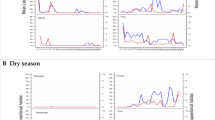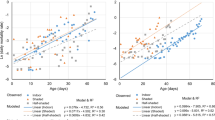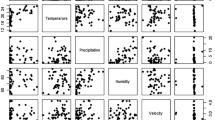Abstract
In recent centuries, the mosquito Aedes aegypti has spread into most urban areas throughout the tropics. This species is considered the main vector of the chikungunya, dengue, yellow fever and Zika viruses and causes major public health issues. The aim of this study is to investigate the relative influence of biotic and abiotic parameters on immature populations of Ae. aegypti. During a one-year-long field experiment, we monitored 108 macroinvertebrate aquatic communities inhabiting four types of water containers across three different urbanized sites in a Neotropical city. A multimodel inference approach revealed that, in addition to abiotic parameters, biotic interactions with aquatic organisms had an important influence on the abundance of Ae. aegypti and that the urbanized site considered influences the outcomes of the interactions. Controphic species other than mosquitoes aided Ae. aegypti development, suggesting a mechanism of facilitation through a chain of processes. However, the abundance of Ae. aegypti was lowered by competition with native mosquito species in the slightly urbanized area and by predation in more urbanized areas. Competitive displacement and reduction, as well as predation by native aquatic organisms, can be considered a form of ecosystem service. The conservation and/or augmentation of natural enemies should improve the short- and long-term success of incompatible and/or sterile insect techniques, thus opening up perspectives for the future of mosquito management.



Similar content being viewed by others
References
Alford RA, Wilbur HM (1985) Priority effects in experimental pond communities: competition between Bufo and Rana. Ecology 66:1097–1105. https://doi.org/10.2307/1939161
Aliota MT, Peinado SA, Dario Velez ID, Osorio JE (2016) The wMel strain of Wolbachia reduces transmission of Zika virus by Aedes aegypti. Sci Rep 6:28792. https://doi.org/10.1038/srep28792
Armitage PD, Cranston PS, Pinder LC (2012) The Chironomidae: biology and ecology of non-biting midges. Springer Science, Dordrecht
Beaulant A-L, Minvielle M (2017) Rapport préliminaire Projet SEAGUY, État de l'art et bibliographie sur l'aléa côtier en Guyane. Meteorological data, Météo France. https://observatoire-littoral-guyane.fr/wp-content/uploads/2017/04/Rapport-preliminaire_projet_SEAGUY_vfinale.pdf
Blaustein L, Chase JM (2007) Interactions between mosquito larvae and species that share the same trophic level. Annu Rev Entomol 52:489–507. https://doi.org/10.1146/annurev.ento.52.110405.091431
Burnham KP, Anderson DR (2002) Model selection and multimodel inference: a practical information-theoretic approach. Springer, New York
Camara DCP, Codeço CT, Juliano SA, Lounibos LP, Riback TIS, Pereira GR, Honório HA (2016) Seasonal differences in density but similar competitive impact of Aedes albopictus (Skuse) on Aedes aegypti (L.) in Rio de Janeiro, Brazil. PLoS One 11:e0157120. https://doi.org/10.1371/journal.pone.0157120
Cheung YB (2002) Zero-inflated models for regression analysis of count data: a study of growth and development. Stat Med 21:1461–1469. https://doi.org/10.1002/sim.1088
Cunha SP, Alves JRC, Lima MM, Duarte JR, Barros LCV, da Silva JL, Gammaro AT, Filho OSM, Wanzeler AR (2002) Presence of Aedes aegypti in Bromeliaceae and plant breeding places in Brazil. Rev Saúde Pública 36:244–245. https://doi.org/10.1590/s0034-89102002000200018
Cunze S, Kochmann J, Koch LK, Klimpel S (2018) Niche conservatism of Aedes albopictus and Aedes aegypti - two mosquito species with different invasion histories. Sci Rep 8:7733. https://doi.org/10.1038/s41598-018-26092-2
Daugherty MP, Juliano SA (2003) Leaf scraping beetle feces are a food resource for tree hole mosquito larvae. Am Midl Nat 150:181–184.
Delatte H, Gimonneau G, Triboire A, Fontenille D (2009) Influence of temperature on immature development, survival, longevity, fecundity, and gonotrophic cycles of Aedes albopictus, vector of chikungunya and dengue in the Indian Ocean. J Med Entomol 46:33–41. https://doi.org/10.1603/033.046.0105
Dufourd C, Dumont Y (2013) Impact of environmental factors on mosquito dispersal in the prospect of sterile insect technique control. Comput Math Appl 66:1695–1715. https://doi.org/10.1016/j.camwa.2013.03.024
Epelboin Y, Talaga S, Epelboin L, Dusfour I (2017) Zika virus: an updated review of competent or naturally infected mosquitoes. Plos Negl Trop Dis 11:e0005933. https://doi.org/10.1371/journal.pntd.0005933
Epelboin Y, Chaney SC, Guidez A, Habchi-Hanriot N, Talaga S, Wang L, Dusfour I (2018) Successes and failures of sixty years of vector control in French Guiana: what is the next step? Mem Inst Oswaldo Cruz 113:e170398. https://doi.org/10.1590/0074-02760170398
Focks D (2007) Toxorhynchites as biocontrol agent. J Am Mosq Control Assoc 33:118–127. https://doi.org/10.2987/8756-971x(2007)23[118:taba]2.0.co;2
Foster WA, Walker ED (2019) Mosquitoes. In: Mullen GR, Durden LA (eds) Medical and veterinary entomology. Academic Press, Amsterdam, pp 261–325
Géoportail (2019) Cartographical data, IGN. https://www.geoportail.gouv.fr/carte. Acessed 1 Sept 2019
Gillies MT, Wilkes TJ (1981) Field experiments with a wind tunnel on the flight speed of some West African mosquitoes (Diptera: Culicidae). Bull Ent Res 71:65–70. https://doi.org/10.1017/s0007485300051038
Griffith TB, Gillett-Kaufman J (2018) Drain fly Psychoda spp. (Insecta: Diptera: Psychodidae). IFAS Extension, University of Florida. https://edis.ifas.ufl.edu/pdffiles/IN/IN122600.pdf
Heard SB (1994) Processing chain ecology: resource condition and interspecific interactions. J Anim Ecol 63:451–464. https://doi.org/10.2307/5562
Honório NA, Cabello PH, Codeço CT, Lourenço-de-Oliveira R (2006) Preliminary data on the performance of Aedes aegypti and Aedes albopictus immature developing in water-filled tires in Rio de Janeiro. Mem Inst Oswaldo Cruz 101:225–228. https://doi.org/10.1590/s0074-02762006000200017
Honório NA, Codeço CT, Alves FC, Magalhaes MAFM, Lourenço-de-Oliveira R (2009) Temporal distribution of Aedes aegypti in different districts of Rio de Janeiro, Brazil, measured by two types of traps. J Med Entomol 46:1001–1014. https://doi.org/10.1603/033.046.0505
Honório NA, Silva WDC, Leite PJ, Gonçalves JM, Lounibos LP, Lourenço-de-Oliveira R (2003) Dispersal of Aedes aegypti and Aedes albopictus (Diptera: Culicidae) in an urban endemic dengue area in the State of Rio de Janeiro, Brazil. Mem Inst Oswaldo Cruz 98:191–198. https://doi.org/10.1590/s0074-02762003000200005
Juliano SA (2009) Species interactions among larval mosquitoes: context dependence across habitat gradients. Annu Rev Entomol 54:37–56. https://doi.org/10.1146/annurev.ento.54.110807.090611
Juliano SA, Lounibos LP (2005) Ecology of invasive mosquitoes: effects on resident species and on human health. Ecol Lett 8:558–574. https://doi.org/10.1111/j.1461-0248.2005.00755.x
Lancaster J, Downes BJ (2013) Aquatic entomology. Oxford University Press, Oxford
Lane J (1953) Neotropical Culicidae. Vol. I and II. Universidade de São Paulo, São Paulo
Lopez LCS, Silva EG, Beltrão MG, Leandro RS, Barbosa JE, Beserra EB (2011) Effect of tank bromeliad micro-environment on Aedes aegypti larval mortality. Hydrobiologia 665:257–261. https://doi.org/10.1007/s10750-011-0605-8
Lopez LCS, Filizola B, Deiss I, Rios RI (2005) Phoretic behaviour of bromeliad annelids (Dero) and ostracods (Elpidium) using frogs and lizards as dispersal vectors. Hydrobiologia 549:15–22. https://doi.org/10.1007/s10750-005-1701-4
Lounibos LP (2007) Competitive displacement and reduction. J Am Mosq Control Assoc 23:276–282. https://doi.org/10.2987/8756-971x(2007)23[276:cdar]2.0.co;2
Lounibos LP, O'Meara GF, Nishimura N (2003) Interactions with native mosquito larvae regulate the production of Aedes albopictus from bromeliads in Florida. Ecol Entomol 28:551–558. https://doi.org/10.1046/j.1365-2311.2003.00543.x
Maneerat S, Daudé E (2016) A spatial agent-based simulation model of the dengue vector Aedes aegypti to explore its population dynamics in urban areas. Ecol Model 333:66–78. https://doi.org/10.1016/j.ecolmodel.2016.04.012
Martínez M, Canneva B, Paggi A (2012) First record of Chironomus (Chironomus) calligraphus Goeldi, 1905 (Diptera: Chironomidae) from Uruguay. Check List 8:260–261. https://doi.org/10.15560/8.2.260
Mellor PS, Boorman J, Baylis M (2000) Culicoides biting midges: their role as arbovirus vectors. Annu Rev Entomol 45:307–340. https://doi.org/10.1146/annurev.ento.45.1.307
Merritt RW, Cummins KW (2008) An introduction to the aquatic insects of North America. Kendall Hunt Publishing Company, Dubuque
Millennium Ecosystem Assessment (2005) Ecosystems and human well-being. Island Press, Washington DC
Mocellin MG, Simões TC, do Nascimento TFS, Teixeira MLF, Lounibos LP, Lourenço de Oliveira R (2009) Bromeliad-inhabiting mosquitoes in an urban botanical garden of dengue endemic Rio de Janeiro. Are bromeliads productive habitats for the invasive vectors Aedes aegypti and Aedes albopictus? Mem Inst Oswaldo Cruz 104:1171–1176. https://doi.org/10.1590/s0074-02762009000800015
Mohajerani A, Bakaric J, Jeffrey-Bailey T (2017) The urban heat island effect, its causes, and mitigation, with reference to the thermal properties of asphalt concrete. J Environ Manag 197:522–538. https://doi.org/10.1016/j.jenvman.2017.03.095
Powell JR, Tabachnick WJ (2013) History of domestication and spread of Aedes aegypti-a review. Mem Inst Oswaldo Cruz 108:11–17. https://doi.org/10.1590/0074-0276130395
Powell JR, Gloria-Soria A, Kotsakiozi P (2018) Recent history of Aedes aegypti: vector genomics and epidemiology records. BioScience 68:854–860. https://doi.org/10.1093/biosci/biy119
Quézédé L (2018) Kourou, histoire d'une ville. Escourbiac l'imprimeur, Paris
R Development Core Team (2015) R: a language and environment for statistical computing. R Foundation for Statistical Computing, Vienna, Austria. https://www.R-project.org/
Riback TIS, Honório NA, Pereira RN, Godoy WAC, Codeço CT (2015) Better to be in bad company than to be alone? Aedes vectors respond differently to breeding site quality in the presence of others. PLoS One 10:e0134450. https://doi.org/10.1371/journal.pone.0134450
Talaga S, Dejean A, Mouza C, Dumont Y, Leroy C (2018) Larval interference competition between the native Neotropical mosquito Limatus durhamii and the invasive Aedes aegypti improves the fitness of both species. Insect Sci 25:938–947. https://doi.org/10.1111/1744-7917.12480
Talaga S, Delabie JHC, Dézerald O, Salas-Lopez A, Petitclerc F, Leroy C, Hérault B, Céréghino R, Dejean A (2015) A bromeliad species reveals invasive ant presence in urban areas of French Guiana. Ecol Indic 58:1–7. https://doi.org/10.1016/j.ecolind.2015.05.027
Talaga S, Dézerald O, Carteron A, Leroy C, Carrias J-F, Céréghino R, Dejean A (2017a) Urbanization impacts the taxonomic and functional structure of aquatic macroinvertebrate communities in a small Neotropical city. Urban Ecosyst 20:1001–1009. https://doi.org/10.1007/s11252-017-0653-6
Talaga S, Leroy C, Céréghino R, Dejean A (2016) Convergent evolution of intraguild predation in phytotelm-inhabiting mosquitoes. Evol Ecol 30:1133–1147. https://doi.org/10.1007/s10682-016-9862-3
Talaga S, Petitclerc F, Carrias J-F, Dézerald O, Leroy C, Céréghino R, Dejean A (2017b) Environmental drivers of community diversity in a Neotropical urban landscape – a multi-scale analysis. Landscape Ecology 32:1805–1818. https://doi.org/10.1007/s10980-017-0542-7
Verdonschot PFM, Besse-Lototskaya (2014) Flight distance of mosquitoes (Culicidae): a metadata analysis to support the management of barrier zones around rewetted and newly constructed wetlands. Limnologica 45:69–79. https://doi.org/10.1016/j.limno.2013.11.002
Yee DA (2008) Tires as habitats for mosquitoes: a review of studies within the eastern United States. J Med Entomol 45:581–593. https://doi.org/10.1093/jmedent/45.4.581
Zheng X, Zhang D, Li Y, Yang C, Wu Y, Liang X, Wang X (2019) Incompatible and sterile insect techniques combined eliminate mosquitoes. Nature 572:56–61. https://doi.org/10.1038/s41586-019-1407-9
Acknowledgments
We are grateful to Andrea Yockey for proofreading the manuscript and to the municipality of Kourou (through the Service Départemental de Désinfection) for permitting us to work inside the city limits. We would also like to thank the Ringuet family and the French Centre de Coopération Internationale en Recherche Agronomique pour le Développement for allowing us to set up experimental sites on their properties. This study received financial support from an ‘Investissement d’Avenir’ grant managed by the French National Research Agency (CEBA, ref. ANR-10-LABX-25–01).
Author information
Authors and Affiliations
Corresponding author
Ethics declarations
Conflict of interest
The authors have declared that no conflict of interest exists.
Informed consent
Informed consent was obtained from all individual participants included in the study.
Research involving human participants and/or animals
This article does not include studies with human participants or animals (vertebrates) conducted by any of the authors.
Additional information
Communicated by M. Traugott.
Publisher's Note
Springer Nature remains neutral with regard to jurisdictional claims in published maps and institutional affiliations.
Rights and permissions
About this article
Cite this article
Talaga, S., Dejean, A., Azémar, F. et al. Impacts of biotic and abiotic parameters on immature populations of Aedes aegypti. J Pest Sci 93, 941–952 (2020). https://doi.org/10.1007/s10340-020-01214-w
Received:
Revised:
Accepted:
Published:
Issue Date:
DOI: https://doi.org/10.1007/s10340-020-01214-w




